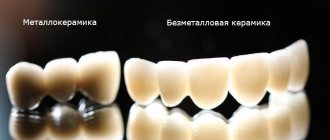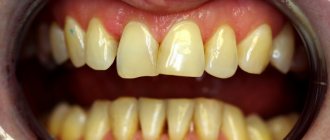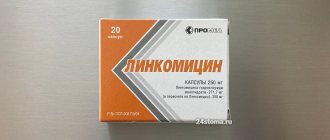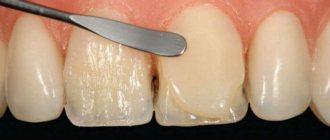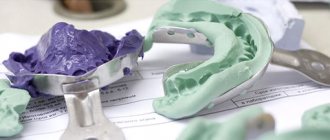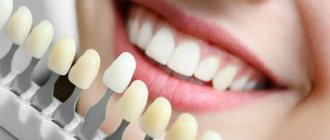Veneers – what are they?
There are two types of veneers:
- Therapeutic. Veneers are made directly on the patient’s tooth. Their composition includes composite materials that are very similar to filling materials. Often such dental devices are used for chipping (in this case, the chipping area can occupy 60%). That is, the procedure can be considered as restoration or extension of a tooth. If we do not consider the case of chipping, then under other circumstances the teeth are ground down a little, a veneer is formed, then they are ground and polished.
- Orthopedic veneers, lumineers. These materials are manufactured in a laboratory environment. In this case, an impression of the patient’s teeth must be taken. They are glued to the tooth using glue specialized for these conditions.
Therapeutic veneers are affordable for many. The price of their installation ranges from 2,500 to 15,000 rubles. The cost threshold depends on the prestige of the clinic, the characteristics of the treatment and the materials used.
Orthopedic ones are much more expensive in price than therapeutic ones. The price starts from 15,000 and goes up to 50,000 rubles. The same factors influence the price here.
Indications and contraindications
Indications for the use of metal-free ceramics include the following clinical cases:
- aesthetic disorders - chips, enamel defects, underdevelopment of the front molars, existing gaps in the frontal zone, distortion of the shape, the absence of one or more teeth, exposed and darkened neck;
- congenital anomalies of the dentition;
- replacement of outdated or worn restorations, broken fillings;
- severe damage to dental tissues caused by extensive caries;
- prosthetics in cases of allergic reactions to metal frame structures.
Contraindications to the use of metal-free ceramics:
- abnormal, deep bite;
- low clinical height of teeth (small teeth);
- the presence of acute conditions in chronic diseases;
- weakened immune system;
- pregnancy;
- frequently recurring attacks of bruxism (teeth grinding), leading to crowding, unevenness, and changes in the shape of the crown of the tooth;
- progressive osteoporosis;
- acute or chronic inflammation of the oral mucosa, periodontal disease, gingivitis.
Installation of veneers
The procedure includes several stages.
- The first stage is preliminary. At this stage, the material and color are determined.
- The second stage is preparation. The procedure involves removing hard tissue from the tooth.
- The third stage is taking an impression. An impression is taken of the tooth and sent to the laboratory.
- The fourth stage is the installation of the plate. The plate is temporary. It is made of plastic.
- The fifth stage is the production of a plaster model in the laboratory. The result is a ceramic plate.
- The sixth stage is fixation of veneers. They are fixed with special glue.
- The seventh stage is removal of cement and assessment of the occlusion.
The success of veneering largely depends on the correct fixation and the materials used.
Fixation of veneers
Three components are involved in fixing a tooth to a plate:
- hard tissues (tooth);
- fixing material for fixing veneers;
- ceramic veneer.
The adhesion strength of these components is the most important requirement in the veneering procedure.
It is very difficult to connect the components. They are all completely different materials. Ceramic veneer is an organic compound. Fixing materials are composite substances containing an inorganic filler or an organic matrix. Teeth are compounds of enamel, dentin, pulp and some others. Due to this composition, it is impossible to obtain a solid bond using a conventional chemical reaction.
Preparatory activities
Before fixation, the following steps must be completed:
- preparing the surface of the veneer itself;
- tooth surface preparation;
- preparation of fixing material (use cement for veneers).
Veneer preparation
The essence of the preparation is to create a certain roughness on the surface of the veneer, which will subsequently come into successful contact with dental tissues. How is it achieved? Hydrofluoric acid (10%) is used as an activator. The surface is etched with it for several minutes (from 1 to 4). The acid does not act on the entire surface, but in selected areas. It only dissolves silicon oxide. The result is the necessary micropores.
To improve the quality of roughness, sandblasting is often used. This process requires good skills. If you are not professional, you can damage the front surface.
Before fixing the veneer to the tooth, it is washed with water and dried.
Afterwards, a silane agent is applied to the inner surface, which gives a binding effect. Silane substances bind tightly to the adhesive and silicon oxide. Such actions are necessary for further tight bonding between the ceramic and the adhesive. The result is that the adhesive thoroughly wets the ceramic surface. Silane application time is 60 seconds. Further steps involve drying the surface using an air jet.
Tooth preparation
Cement, gel (used for fitting) and other foreign substances are carefully removed from the tooth enamel. To do this, use a sandblasting machine and rotating brushes. Afterwards, the surface is etched with phosphoric acid (37%). Acid etching creates the necessary microrelief, which further promotes adhesion. The etching exposure is 30 (40) seconds. If dentin is etched, the time is no more than 15 seconds. Its increase can provoke the collapse of collagen fibers.
When finished, wash off the phosphoric acid with plenty of water. Primer is applied to the tooth surface, left for 30 seconds and dried well. Finally, adhesive is applied. The actions are carried out simultaneously with the application of adhesive to the prepared veneer surface. This is the adhesive fixation of the veneers.
Preparation of fixation material
The fixation material is a different composite material. A wide variety of materials allows you to choose. The selected material is applied to the surface of the veneer from the inside and pressed against the tooth with careful movements. The composite material that has protruded beyond the surface of the tooth is removed. After polymerization has taken place, the tooth is ground, polished, and checked. Particular attention is paid to the adhesive seam. If this is required, then a general adjustment is made.
Cement is used as a material to fix veneers. There are many different fixation operations performed in dentistry. Unfortunately, it is not possible to use the same material everywhere. Its properties are not always suitable for fastened elements.
The ideal cement for veneers is a material that has good adhesion to the tooth structure and to the veneers themselves. And it must have the following requirements:
- resistance to various types of loads;
- ease of use and subsequent cleaning;
- insolubility in oral fluids;
- resist caries;
- even a small layer thickness should give high efficiency.
Variolink Veneer dental composite cement meets these requirements. It is intended for fixation of restorations (composite and ceramic) whose thickness does not reach 2 mm.
Variolink veneer has the following necessary and important characteristics:
- high wear resistance;
- high color fastness;
- very good consistency;
- high adhesion strength;
- high translucency;
- ease of removal.
The main stages of manufacturing metal-free ceramics
Preparation for prosthetics and production of restoration structures occurs according to the following scheme:
- assessment of the general condition of the oral cavity, diagnostic measures by an orthopedic dentist with determination of the method of prosthetics;
- therapeutic preparation, including: removal of dental plaque, treatment, if necessary, canal filling, pulp removal, strengthening with a fiberglass pin;
- the color of the future prosthesis or crown is selected;
- preparatory grinding of the tooth for a crown, formation of a stump. If there is severe tooth decay, the stump is formed from a ceramic inlay;
- An impression of both jaws is taken and sent to the prosthetic laboratory for further modeling and production of crowns or dentures;
- if necessary, production of the structure frame;
- applying ceramic masses to the frame;
- firing in a kiln;
- preliminary, then final fittings in the oral cavity;
- installation of the structure, its adjustment and fixation with especially strong dental cement.
Production technology
To apply ceramic mass to metal-free ceramic prostheses or crowns, the following technologies are used:
- electroplating with the production of frames and their subsequent ceramic lining with galvanic ceramics formed from sedimentary ions of the molding material in a galvanic bath. The electrochemical deposition process allows you to obtain an exact copy of the tooth model placed in the bath, even the most complex, unique configuration.
- CAD-CAM technology using 3D computer modeling. Work on the manufacture of dentures is carried out in stages - a three-dimensional model of the dental arch is created with a scanner and the desired shape of the dentures is determined, then on a computer, with the necessary software, the parameters of the crown are modeled and designed, after which, according to the designed parameters, a milling machine is used to grind out the blank of the patient’s unique dental frame. The three-dimensional modeling technique allows you to correctly restore the physiology of interdental contacts and obtain a dental prosthesis of an exact anatomical shape;
- press casting method, lithium disylate ceramics. Using this technology, dental impressions are first made, which are then used to form a plaster model and the wax model is molded. The molding material is placed in it, it is pressed in and the sprue wire is installed on a phosphate binder. The pressing process takes place in a specially selected flask located in a press oven. After hardening, the mold is placed in a calcination muffle furnace with a final heating temperature of 920°C;
- innovative type of pressed glass ceramics Emax, Empress. The basis for all-ceramic structures is lithium disilicate blanks.
Lumineers
The perfect (Hollywood) smile can be achieved with lumineers. The design of lumineers is slightly thinner than conventional veneers. The shape is similar to petals. To fix lumineers, veneer adhesive is used.
There are standard and individual lumineers. The former have a variety of colors and sizes. They are somewhat similar in installation to false nails. The latter are made in the laboratory depending on the individual characteristics of the patient.
Lumineers increase the volume of teeth. They are used in cases:
- Slight discoloration of teeth. The design of the devices is very thin (0.3 mm), translucent, so they cannot hide the obvious unevenness of color.
- Small diastemas between teeth. Lumineers cover them well.
- The presence of chips on the teeth and their concealment. Here, individual lumineers will be used, in which the thickness at the chip site should be greater.
- The appearance of cracks in the enamel that you want to hide.
Lumineers have a significant drawback, which manifests itself in a short service life due to low reliability. Broken material unfortunately cannot be repaired. Some procedures will need to be completed first.
A positive aspect of veneering is that the glue on which it is attached contains the element fluorine. Therefore, experts say that wearing such structures is beneficial for tooth enamel.
After installing the veneers, the dentist will invite the patient for a second appointment. This will happen in about a week. The doctor will examine your teeth and gums. He will look at how the teeth have adapted to the installed material. In addition, the doctor can perform the final steps to adjust the veneers. That is, after his manipulations, the mouth will look even better. Now it will be easier for the tooth and veneer to cope with their functions.
Advantages
Metal-free ceramic structures do not require a metal frame; they use a natural mineral, zirconium oxide (ZrO2), as a base, onto which a ceramic composition is subsequently applied. Due to its special physical and chemical characteristics, the material is not only characterized by high resistance and bending strength, but also has a structure similar to the human skeletal system. Its main biotechnological advantages include:
- strength and durability;
- special, aesthetically attractive liveliness and natural appearance of the restored dental surfaces. Excellent light and color rendition of the transparency and shine of real teeth;
- an ideal contact surface of the frame structure of the denture to the patient’s tissues, as a result of which the penetration of disease-causing pathogens and the development of periodontal disease and caries is impossible;
- maximum preservation of the vitality of dental surfaces. Minimal grinding of the supporting or crowned teeth is necessary (ultra-thin thickness of the installed frame, not >0.3-0.4 mm), above the gingival surface, without disturbing the circular ligament of all dentitions;
- complete bio-inertness (harmless to humans) and compatibility with periodontal tissues, hypoallergenic properties, absence of allergic reactions;
- high shock absorption capacity, low load on the periodontium;
- low surface porosity, eliminating the possibility of subsequent appearance of tartar and plaque;
- metal-free ceramics do not cause rejection;
- versatility of application - both frontal and chewing groups can be restored;
- protection from temperature changes in the oral cavity and complete absence of painful reactions to cold or heat;
- do not change color during wear, do not wear out;
- comfort and ease of wearing orthopedic design;
- ease of subsequent care.
Situation: veneer failed
In practice, there were cases when the veneer fell off. How to fix? You need to assess the situation and carefully study the problem, and the doctor will suggest a solution.
If the material has simply peeled off, then you need to remove it with careful movements (so as not to damage it).
If you see in your mouth that one part has peeled off, then there is a possibility that the device remains intact. If the veneer falls off as a whole, then the doctor will definitely be able to fix it in place.
In case of obvious breakdown of the material, the dentist will have no other solution but to replace it with a new one.
How can you tell if the entire veneer has fallen off? You need to look at the condition of the fallen element. If it has a symmetrical and rounded shape, then the veneer is intact. If you look closely at the tooth and see a residue on it, then the veneer is 100% broken.
In order to help the dentist with further treatment, you must show him the fragments. It is recommended to save all parts of the broken material. To do this, you need to fill a small box with cotton wool and put the debris there.
Next, you need to report the incident to the doctor. The doctor will solve the problem. But in general, the potential risk of such a problem is small. The tooth will remain without protection for some time (two weeks). There will be no significant changes in him for weeks.
Veneer detachment can be detected independently. It happens that you feel a rough surface (as opposed to a smooth veneer) in your mouth. The tip of the tongue undergoes irritation. And yet, a ground tooth will definitely react to temperature changes, since the surface has no protection.
And in the future, carefully analyze the situation and determine what actions you took could cause the breakdown. Once you find the answer, never repeat such actions again. If you cannot determine, consult your dentist.
Care
If you take special care of your veneers, you can wear them for decades. In this case, of course, it is necessary to undergo preventive examinations. What are the care activities? They need to be cleaned thoroughly twice a day. You can use both a brush and paste.
Veneers are installed for cosmetic purposes. It should be remembered that the strength of the material is low, so you need to take care of their condition. It is necessary to ensure that bad habits (for example, biting nails) do not find a place in the patient’s life. In addition, you should not consume foods that are colored (for example, coffee, tea).
Sources used:
- “Aesthetic dentistry and ceramic restorations (Tuati B.)
- Criteria for evaluating composite dental restorations / A.I. Nikolaev and others - M.: MEDpress-inform, 2015.
- “Adhesive ceramic restorations” (Manier P.)
- National Library of Medicine (USA)
Price of ceramic crowns
Average cost of ceramic microprostheses:
- Emax solid crown – from RUB 13,000. for 1 unit;
- metal-free crown made of zirconium dioxide – from RUB 16,000.
This price does not include temporary plastic onlays (about 1000 rubles), as well as the removal of diagnostic impressions (from 800 rubles).
If you are looking for dentistry with affordable prices for prosthetics, we suggest looking at the list of clinics on our website. Just enter the desired city area into the search system.
